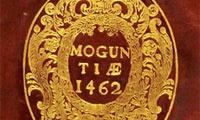Rarity and preciousness are the two main criteria that characterize pieces of the Rare Works heritage, derived from several collections of the Brazilian National Library. To integrate this set, it is not enough to be an antique work, it is also necessary to be unique, unreleased, to be part of some special edition or to present some distinction trace. It can be a deluxe binding or the autograph of a celebrity such as D. Pedro II, Coelho Neto, Carlos Drummond de Andrade or Jorge Amado. Rare periodicals published until the 19th century also compose this heritage.
This precious collection enchants the visitors with its pieces from the 15th to the 20th centuries; among which is detach the first documents generated by the moveable type printing process, the `incunabulum'. Frequently, public can also appreciate expositions that show rare copies of this rich heritage. These samples assembly have also the intention of awaking the feeling of belonging in the population, while noticing the patrimony value that Brazil has.
Altogether, there are more than two thousand linear meters of items in bookshelves, drawers and safes, housed in a space that, by keeping this rich treasure, is considered a vault room. The place gained the name of its protector, João Antonio Marques, bibliophile, resident in Portugal, who donated his valuable collection of `incunabulum', princeps and camonianas editions, and other printed matters and manuscripts related to the colonial period.
Works originated from different nations are preserved according to:
- The magnitude of their Brasiliana (recorded or printed books about Brazil, between the 16th and 19th centuries, and books of Brazilian authors printed or recorded abroad up to 1808).
- The recurrence of “Brazilian incunabulum”.
- The intellectual and historical character of their headings.
- The material wealth of supports (leathers, parchments, wood, papers of rag and wood, silks, velvet and taffeta).
Preciousness
- Parchment dated from the 11th century with manuscripts in Greek about the four Gospels, the oldest copy of the Brazilian National Library and Latin America.
- “Bíblia de Mogúncia”, from 1462, first printed work to contain information such as dates, place of printing and the names of the printers, the Germans Johann Fust and Peter Schoffer, former-partners of Gutemberg.
- Nuremberg chronicle, from 1493, considered the most illustrated book of the 15th century, with woodcut maps known as the oldest in printed book.
- Antwerp Polyglot Bible, from 1569, the monumental Work of the most renowned printer of the 16th century: Cristóvão Plantin.
- “Os Lusíadas” first edition, from 1572.
- The “Art of Portuguese language grammar” first edition, written by Priest Jose de Anchieta in 1595.
- The “Rerum per octennium… Brasilia”, from Baerle (1647), with 55 colored planks drawn by Frans Post.
- Complete copy of the famous Encyclopédie Française, one of the works of reference for the French Revolution.
- The first printed periodical of the world, dated 1601.
- Unique copy and considered as the extreme rare from the book published in 1605 by author Hrabanus Maurus, who created the word puzzles in form of visual poetry.

